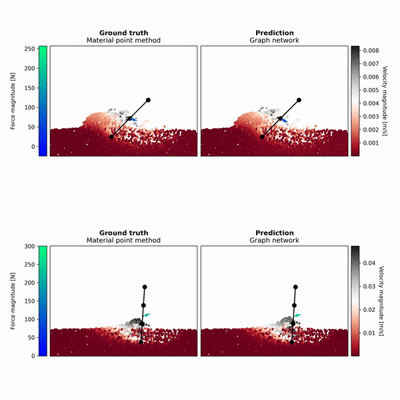Modeling granular materials interacting with machines typically involves a tradeoff between fidelity and computational efficiency. Discrete Element Method (DEM) models soil as a collection of millions of individual particles, while classical terramechanics equations offer simple empirically-based approximations. Our research has extended continuum methods, specifically Material Point Method (MPM) with nonlocal granular fluidity, to 3D simulations of wheel and excavator interactions to produce a balance of accuracy and efficiency. Further, we have found that these methods capture the important effects of gravity on granular interactions. We have also trained significantly accelerated models by combining dimensionality-reduction techniques and Graph Neural Networks (GNNs), using experimentally-validating MPM datasets to train these machine learning approaches.
Haeri A*, Holz D, Skonieczny K. (2024). Subspace Graph Networks for Real-Time Granular Flow Simulation with Applications to Machine-Terrain Interactions. Engineering Applications of Artificial Intelligence. 135: 108765.
Haeri A*, Skonieczny K. (2022). Gravity sensitivity of continuum numerical solvers for granular flow modeling. Granular Matter. 24(2): 66: 1-17.
Haeri A*, Skonieczny K. (2022). Three-dimensional granular flow continuum modeling via material point method with hyperelastic nonlocal granular fluidity. Computer Methods in Applied Mechanics and Engineering. 394: 114904: 1-21.
Karpman E, Kovecses J, Holz D, Skonieczny K. (2020). Discrete element modelling for wheel-soil interaction and the analysis of the effect of gravity. Journal of Terramechanics. 91: 139-153.
Usmani MJ*, Skonieczny K. (2023). Accelerating Graph Networks for Real-Time Physics Simulations. ISTVS 16th European-African Regional Conference. Lublin, Poland.
Haeri A*, Tremblay D, Holz D, Teichmann M, Skonieczny K. (2021). Experimental exploration and real-time simulation of the soil flow in blade-soil interactions. International Society for Terrain-Vehicle Systems (ISTVS) International Conference. Online.
Haeri A*, Skonieczny K. (2021). Accurate and Real-time Simulation of Rover Wheel Traction. IEEE Aerospace. Online.

Concordia University's Aerospace Robotics Lab
Research interests include: Space robotics, Planetary rovers, Robot mobility, Vehicle-terrain interactions, Advanced 3D printing techniques, Robotics excavation & construction, Reduced gravity experimentation, Computer vision and machine learning for robotics applications.
